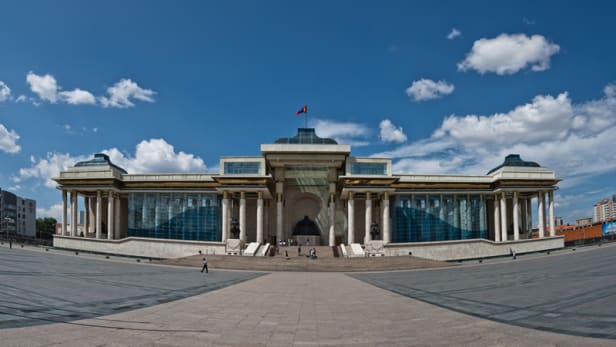By Ashleigh Whelan, Craig Castagna
 |
| The Government Palace in Ulaanbaatar, Mongolia. Photo by: Marco Fieber / CC BY-NC-ND |
“All politics is local” is a maxim so common as to become clichéd. Yet the wisdom applies to development work around the world.
Locally driven approaches to democracy and governance are valuable on a number of fronts, and we have found this particularly true in anticorruption programs. Anticorruption policies require a bottom-up approach that appreciates the current landscape, as well as the opportunities for corruption. They need to be able to access citizens directly, as only local governments have the capacity to do on a daily basis.
As in many countries, corruption is a key hindrance to development in Mongolia. The problem is very much on the minds of the Mongolian people: 76 percent of voting age Mongolians identify corruption as a major problem in the country. Several civil society organizations are dedicated to monitoring service delivery, and the government has formed an Independent Agency Against Corruption, tasked with conducting oversight of government officials and educating the public.
The municipal leadership in the capital of Ulaanbaatar, including former Mayor E.Bat-Uul and current Mayor Su.Batbold, sought out the International Republican Institute to help it engage with citizens and enhance civil servants’ knowledge and capacity to fight corruption.
Here’s what we learned:
1. Consultation is key. Working directly with the mayor, we were able to establish an anticorruption initiative within City Hall that convenes civil servants, civil society representatives and citizens. Through a consultative arrangement, citizens are able to identify gaps in transparency and accountability and devise solutions. For example, the initiative has worked to provide easy-to-comprehend materials that inform citizens on how public funds are allocated and spent.
2. Focus on prevention. One route to reform is to focus on prevention, by identifying susceptibilities to corruption before they happen. System inefficiencies are often visible when partnering with a country’s local government. In Ulaanbaatar, we quickly established that budgetary malfeasance, facilitated by opaque rules and procedures, provided opportunities for corrupt behaviors or actions.
3. Foster inclusion through partnerships. As with any anticorruption strategy, it’s important to be able to present findings in a manner that is truthful but does not alienate key stakeholders. Partnerships that involve a variety of actors in agenda-setting and decision-making can build an inclusive, problem-solving approach, rather than top-down recommendations.
This was the logic underpinning the rollout of IRI’s Vulnerabilities to Corruption Assessment tool, first piloted in 2014 in Ulaanbaatar. The rollout of this formalized structure helped us identify the key elements that make governments susceptible to graft, with wide-ranging application for implementers across the anticorruption field.
Why local government?
We have found that this approach is most effective when applied to local governments, as these entities play a direct role in providing everyday services to citizens and have the most interaction with the public. Armed with the lessons derived from the VCA, municipalities are able to better design interventions that will enable them to transform, over time, into “oases of good governance.” Change in one area creates a positive precedent for neighboring local governments.
This approach doesn’t end with the assessment. Rather, the tool can be employed to kick off a series of actions to address the vulnerabilities identified. As a result of our 2014 assessment in Mongolia, we have been working with the government of Ulaanbaatar to strengthen knowledge of ethics and have helped to design mechanisms to prevent conflicts of interest among civil servants. For example, infographic-style budget literacy tools have equipped citizens and the civil society organizations to monitor public expenditure and advocate for policy changes accordingly. The citizens of Ulaanbaatar recently did just that regarding educational spending.
Of course, following up these types of assessments with effective initiatives is by no means easy. Solutions require significant political will. It may require more time and effort than tackling individual cases of corruption to, for example, establish a task force of civil servants charged with finding cost-effective solutions for irregularities in identification cards processing. But the impact can also be more significant, attacking the systemic weaknesses that corrode public trust and faith in democracy.
Not all municipalities will have leaders willing to spend the political capital to become involved in this process. However, by highlighting successes and facilitating intra-country learning, development practitioners can present a persuasive case for local governments to serve as incubators for reform and action. In our experience, when initiatives are put forward as practical steps intended to increase citizen satisfaction, as opposed to top-down, punitive or politicized measures, government officials are more open to participating. This can also help anticorruption to stay on the agenda after a transfer of power between parties, helping to bolster the program’s sustainability.
This is not to argue that there is no place for nationwide anticorruption efforts facilitated by development implementers in Mongolia. But our experience in Ulaanbaatar highlights that municipal governments can become drivers of wider systemic reform — engaging both the officials and the “little platoons” that are crucial to achieving genuine improvements. It turns out all politics really is local — and that goes for the development sector, too.

No comments:
Post a Comment